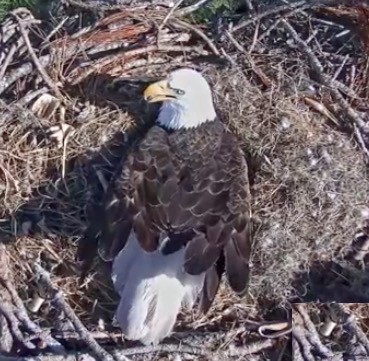As people watch across the planet for the arrival of two baby American Bald Eagles hatching from their eggs, something magical is happening! Cracks have appeared on one of two of the grand mother bird’s eggs!
The live stream, emanating from the Dick Pritchett Real Estate in Florida, has given thousands of watchers a birdseye view of the amazing and majestic event. American Bald Eagle Harriet and her mate M15 have been taking turns incubating two eggs in their 6-foot-wide nest located 60-feet up a slash pine tree in the Fort Myers area.
|
Advertisement |
Here are some fast facts:
Camera #1 is positioned six feet above the nesting tree and is equipped with night vision or infrared light, which emits no actual light. Nor does it make any noise. The birds do not see or hear anything coming from the camera. Camera #2 is located approximately 60 feet from the nest and has the ability to capture images of the nest action outside the view of Camera #1. (See diagram right for picture of cam locations) Both cameras are environmentally friendly, non-intrusive and positioned to offer the best view of the nest and birds while preserving the pristine beauty of the nest and their surroundings. h/t dickpritchettrealestate
A third camera (Cam #3) is installed closer to the north of the pond, to capture activity happening around the pasture and in the pond area.
•The original adult bald eagles pair, known as Ozzie and Harriet, had been coming to this nest since 2006. After Ozzie’s passing in the early fall of 2015, Harriet & M15 bonded in late fall of 2015. This is their second season as a mated pair at this location.
• While spotted most months out the year in the area, they officially reside in this nest between the months of October and May.
• The nest sits 60 feet above the ground, in a Slash Pine tree. In the Spring of 2016, the nest detrioriated and completely fell apart. This season, if they re-build, will be a brand new nest for this couple.
• The nest camera faces South East.
• The pair relocated the nest from across the street to its current location for the 2006-2007 nesting season. This nest is labeled LE026-B of the Florida State Monitoring Program. It has been monitored at this location for 8 years.






